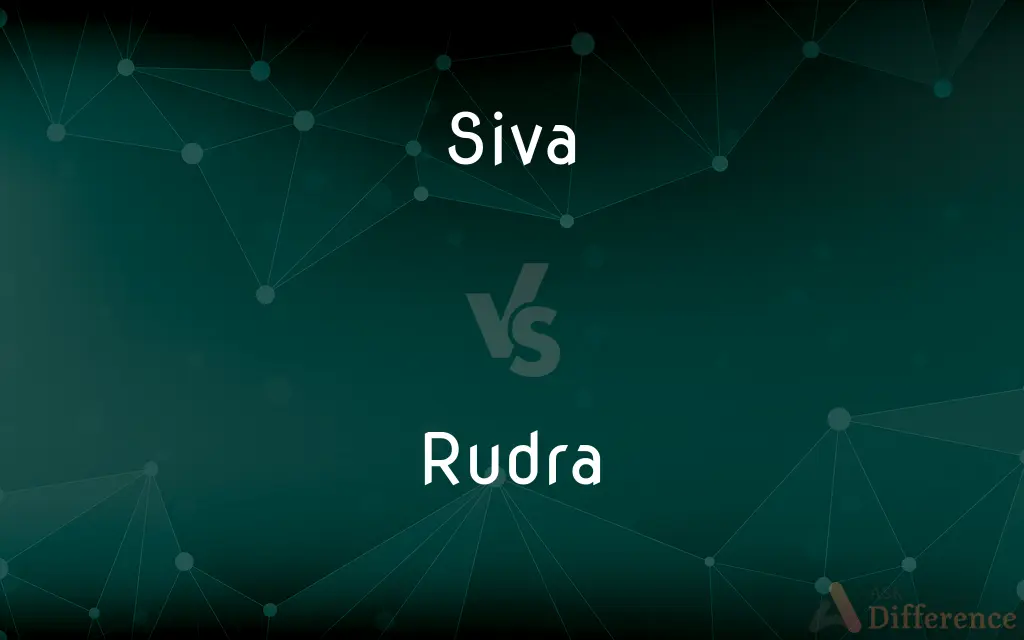Siva vs. Rudra — What's the Difference?
By Urooj Arif & Maham Liaqat — Updated on April 18, 2024
Siva (Shiva) is a major Hindu deity symbolizing destruction and renewal, often revered as the supreme being, while Rudra, a Vedic storm god, is considered an early form of Shiva, associated with storms and hunting.

Difference Between Siva and Rudra
Table of Contents
ADVERTISEMENT
Key Differences
Siva, commonly known as Shiva in Hinduism, is one of the principal deities of the religion, known for his roles as the destroyer and transformer within the Trimurti, alongside Brahma and Vishnu. He is worshiped as a supreme being who embodies destruction, which is necessary for rebirth and renewal. On the other hand, Rudra is an ancient Vedic deity, initially known as a storm god and a hunter, feared for his fierce and tumultuous nature.
Shiva is depicted with a serene and meditative demeanor, often seated in a yogic posture with a trident (Trishula) and a drum (Damaru), symbolizing his control over time and the rhythm of cosmic vibrations. Whereas Rudra is described in early Vedic scriptures as howling and ferocious, with a bow and arrows, bringing storms and disease, highlighting his untamed aspect.
In terms of worship and iconography, Shiva is extensively revered across the Indian subcontinent and has many temples dedicated to various aspects of his persona, such as the benevolent benefactor and the fearsome destroyer. Rudra, while still recognized as an aspect of Shiva, does not have a similarly extensive independent worship in contemporary Hindu practices.
Theological development in Hinduism integrates Rudra into the more complex and benevolent character of Shiva over time. Early texts depict Rudra as a god of might and terror. In contrast, later literature and Puranic texts expand Shiva's character to include his roles as a creator, preserver, and destroyer, illustrating a synthesis of various tribal and cultural deities into a single major god.
Both Shiva and Rudra are associated with the power of destruction, but Shiva’s role extends to that of regeneration and reproduction, symbolizing the cyclical nature of the universe. He is often shown with a crescent moon on his head and the river Ganga flowing from his hair, denoting fertility and purity. Meanwhile, Rudra's connection to nature and the wild remains significant in his identity as a protector of animals and healer of diseases, although these roles are less emphasized in his overlap with Shiva.
ADVERTISEMENT
Comparison Chart
Role in Hinduism
Supreme being, part of the Trimurti
Ancient Vedic storm god, Shiva's early form
Iconography
Trishula, Damaru, serenity
Bow and arrows, storms, fierceness
Worship
Extensively worshiped, numerous temples
Limited contemporary worship
Theological Evolution
Synthesis of various deities into a supreme being
Initially a fierce deity, integrated into Shiva
Symbolism
Destruction and renewal, fertility, purity
Storms, hunting, protector of animals
Compare with Definitions
Siva
Worshiped as a yogi who maintains cosmic order.
Devotees often meditate to images of Shiva seated in tranquil contemplation.
Rudra
Known for his fierce and fearsome temperament.
Rudra’s howls are said to foretell the arrival of tumultuous weather.
Siva
One of the principal deities in Hinduism, known as the destroyer.
Shiva's dance, Tandava, symbolizes the cosmic cycles of creation and destruction.
Rudra
Represents the wilder, untamed aspects of nature.
Rudra's character is integral to understanding the primal forces within Hindu cosmology.
Siva
Associated with the Lingam, a symbol of his generative powers.
The Shiva Lingam is central in rituals across Shiva temples.
Rudra
Integrated into Shiva, enriching the god's attributes.
Rudra's characteristics are observed in Shiva’s roles as a cosmic dancer and destroyer.
Siva
Known for his third eye, which symbolizes destruction and clairvoyance.
When Shiva's third eye opens, it heralds significant cosmic events.
Rudra
A Vedic deity associated with storms and hunting.
Rudra is called upon in ancient hymns to harness his raw energy and power.
Siva
Often depicted with a blue throat, symbolizing the poison he consumed during the churning of the ocean.
Shiva's blue throat is a testament to his sacrifice and protective nature.
Rudra
Worshiped as a healer of diseases and protector of animals.
Rudra is revered in pastoral communities for his healing and protective aspects.
Siva
Variant of Shiva.
Rudra
Father of the storm gods Marut; controller of nature; sometimes identified with Siva
Siva
One of the triad of Hindoo gods. He is the avenger or destroyer, and in modern worship symbolizes the reproductive power of nature.
Siva
The Destroyer; one of the three major divinities in the later Hindu pantheon
Common Curiosities
Is Shiva and Rudra the same deity?
Rudra is an ancient form of Shiva but with distinct aspects; over time, Rudra was assimilated into Shiva's more complex character in Hinduism.
What are the main icons associated with Shiva?
Shiva is often depicted with a trident, drum, and crescent moon, each symbolizing different aspects of his divine functions.
How is Rudra worshiped in contemporary Hinduism?
While direct worship of Rudra is less common now, he is recognized in prayers and hymns, particularly in the Rudra aspect of Shiva.
What does Shiva’s third eye represent?
It represents destruction and spiritual insight, capable of annihilating evil and ignorance.
Why is Shiva often shown meditating?
Meditation symbolizes Shiva’s role as an ascetic and his domain over the forces of life and death through deep meditation.
How are Rudra’s storm elements reflected in Shiva?
Shiva’s dance, the Tandava, reflects the dynamic and destructive nature of storms, akin to Rudra’s stormy disposition.
What does Shiva symbolize in Hinduism?
Shiva symbolizes the cycle of creation, destruction, and renewal, essential for cosmic regeneration.
Why is Rudra feared?
Rudra is associated with storms and destruction, making him a deity that is both revered and feared for his power.
What role does the Lingam play in Shiva worship?
The Lingam represents Shiva’s generative powers, emphasizing fertility and the cyclic nature of life.
What is the significance of Shiva’s blue throat?
It signifies his act of consuming poison to protect the universe, highlighting his sacrificial nature.
Can Rudra be considered a creator deity?
Rudra's role is more focused on control and balance of the wild and fierce aspects of nature, unlike Shiva's broader creator role.
Is Rudra associated with any animals?
Yes, Rudra is often linked to cattle, reflecting his pastoral origins and role as a protector.
How does the integration of Rudra into Shiva affect Hindu theology?
It enriches the character of Shiva, adding layers of complexity and integrating different cultural and religious traditions within Hinduism.
Why is Shiva depicted with a snake around his neck?
The snake symbolizes control over desires and power, integral to Shiva’s role as the destroyer and regenerator.
What is Shiva’s role in the Trimurti?
As part of the Trimurti, Shiva’s role is to destroy the universe in order to prepare for its renewal by Brahma.
Share Your Discovery

Previous Comparison
Quesadilla vs. Enchilada
Next Comparison
Inclarity vs. UnclarityAuthor Spotlight
Written by
Urooj ArifUrooj is a skilled content writer at Ask Difference, known for her exceptional ability to simplify complex topics into engaging and informative content. With a passion for research and a flair for clear, concise writing, she consistently delivers articles that resonate with our diverse audience.
Co-written by
Maham Liaqat















































